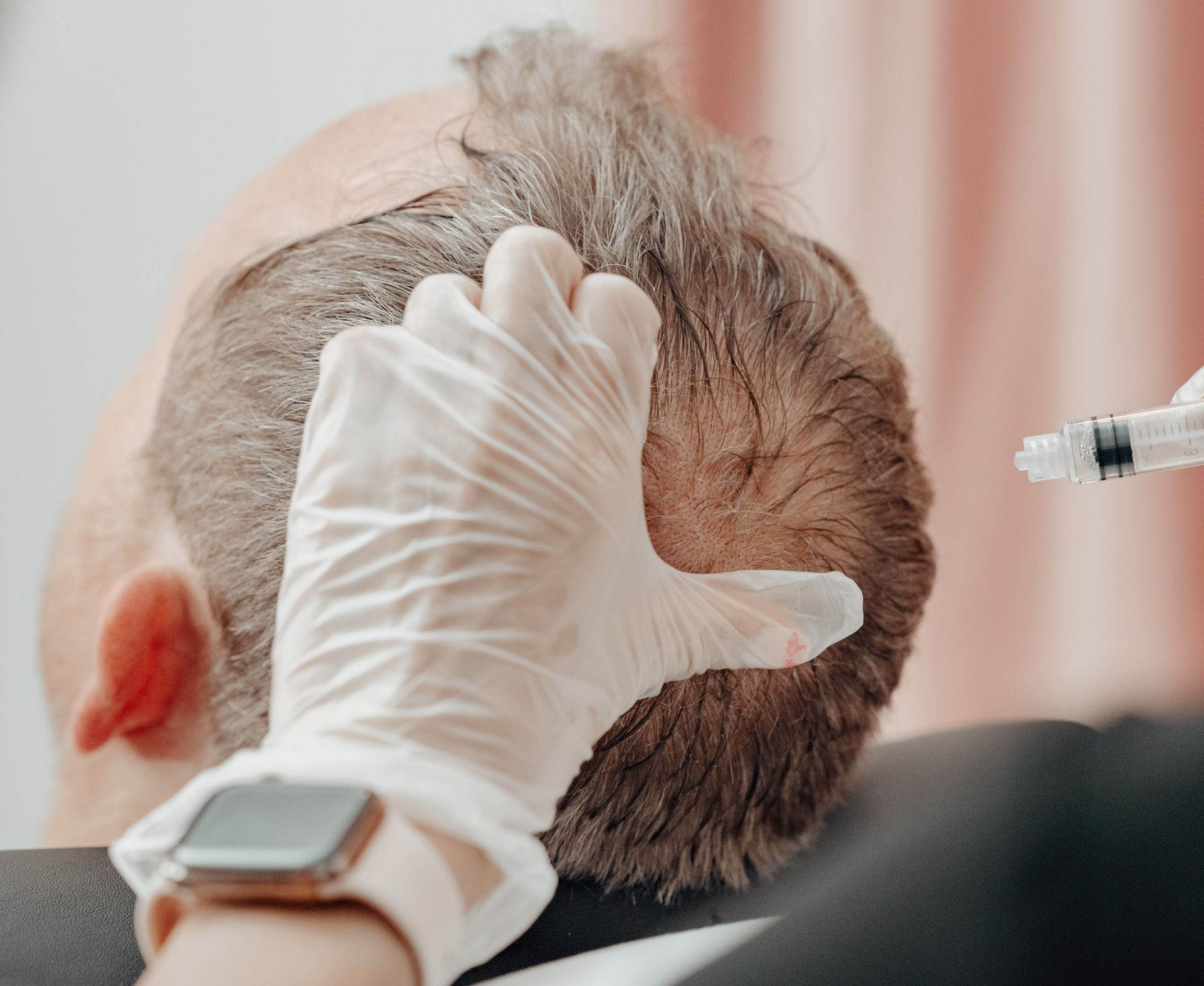What is Male Pattern Baldness?
Male Pattern Baldness, also known as Androgenic Alopecia, is a prevalent disorder that causes slow and predictable hair loss in males as they age.
Androgenetic Alopecia is the medical term for this hair loss. "Andro" refers to androgens, essential in this illness, and "genetic" means hereditary. "Alopecia" is a medical term for hair loss in general.
The progression of Male Pattern Baldness typically follows a specific pattern. It usually begins with a receding temple hairline and crown hair thinning. These spots may become more prominent, forming a "M" on the forehead. The back and sides of the head may develop a horseshoe-shaped fringe when the hairline recedes.
This disorder is more common in men, however female pattern baldness can also affect women. The underlying cause in both cases is the same: a genetic predisposition to sensitivity to androgens.

Causes of Male Pattern Baldness
Understanding Male Pattern Baldness requires understanding its causes. Exploring these critical features can help us understand this disorder and find prevention and treatment methods.
Hormonal Factors
DHT is key to male pattern baldness. It's a potent form of the male hormone testosterone. This hormone can affect scalp hair follicles. Miniaturization can result from DHT interaction with these follicles. Over time, hair follicles diminish, making hair thinner and shorter.
Genetic Predisposition
Family history plays a significant role in male pattern baldness. If your father, grandfather, or other male relatives lost hair, you're more likely to too. Specific genes make hair follicles more vulnerable to DHT.
Aging and Hair Loss
Age raises the chance of male pattern baldness. Due to hormones like DHT, this becomes more noticeable with age. DHT can damage hair follicles by making them less sensitive to growth signals.
Hair Follicle Sensitivity
It's essential to understand that not all hair follicles are created equal. Men with male pattern baldness have more sensitive temples and crown hair follicles to DHT. This heightened sensitivity increases miniaturization, causing bald areas.
Lifestyle and Environmental Factors
Lifestyle and environmental factors can worsen male pattern baldness caused by hormonal, genetic, and age causes. Smoking, poor nutrition, and stress can hasten hair loss in genetically prone people. These factors are secondary influences, not the root cause of male pattern baldness.
Symptoms and Signs of Balding
Recognizing male pattern baldness symptoms is the first step to treating this widespread issue. These signs and symptoms can help you spot male pattern baldness early on.
- Thinning Hair: One of the initial signs of male pattern baldness is a gradual thinning of hair, primarily at the crown or the top of the head.
- Receding Hairline: Another common symptom is a receding hairline. This occurs when the hairline starts moving backward, forming an "M" shape or a pronounced widow's peak.
- Excessive Hair Shedding: Men with baldness may notice more hair shedding than usual, particularly when combing or washing their hair. This can be a source of concern for many.
- Bald Spot: Over time, bald spots may develop on the scalp, especially in the vertex or crown area. These bald patches can vary in size and may become more prominent as hair loss progresses.
- Miniaturized Hair: In male pattern baldness, the affected hair follicles produce thinner, finer, and less pigmented hair. These miniaturized hairs are often referred to as "peach fuzz."
7 Stages of Baldness(The Hamilton-Norwood Scale)
This commonly used scale helps men and women diagnose and classify hair loss stages. Examine each step to see how this natural event influences appearance and self-esteem.
Stage 1: Minimal Recession
At the initial stage, a minimal recession occurs. This stage is characterized by a subtle but noticeable recession of the hairline at the temples. It's often the earliest sign of male pattern baldness, and the changes in appearance are relatively mild.
Stage 2: Frontal Hairline Recession
There's a further frontal hairline recession. In this stage, the hairline recedes more noticeably, creating a slightly more pronounced M or U shape on the forehead. It still primarily affects the frontal region of the scalp, and the overall impact on appearance is moderate.
Stage 3: Temporal Recession
This stage introduces temporal recession, forming a clearer M or U shape pattern. This stage sees the continued progression of hair loss towards the temples, resulting in a deeper recession. It's important to note that hair loss at this stage remains concentrated in the frontal and temporal areas.
Stage 4: Frontal Balding
Frontal balding becomes evident. Hair loss extends further back into the frontal region, creating a noticeable balding area. While the crown may still have significant hair coverage, the frontal appearance is significantly affected.
Stage 5: Crown Balding
Characterized by crown balding. Hair loss now expands to the crown of the head, creating a more pronounced bald spot. The combination of frontal and crown balding results in a distinct horseshoe-shaped pattern of remaining hair.
Stage 6: Advanced Frontal Balding
Frontal balding advances further. The frontal hair loss becomes more extensive and severe. This stage often involves significant thinning in the frontal region, leaving less hair coverage in that area.
Stage 7: Advanced Crown Balding
The final stage represents advanced crown balding. The crown bald area gets even more noticeable, and the remaining hair is usually on the sides and back. Severe crown balding is the hallmark of this stage, impacting the overall appearance significantly.
Diagnosis and Evaluation
Accurate diagnosis and thorough evaluation are essential in healthcare. Here are the steps and methods involved in this vital aspect of medical care.
Medical History
Begin the diagnosis process by sharing your medical history with your healthcare provider. Inform them about any underlying health conditions, medications, or family history of hair loss. This information helps in understanding potential causes and risk factors.
Physical Examination
Your healthcare professional will conduct a thorough physical examination of your scalp. They will assess the pattern and extent of hair loss, paying attention to the front, top, and crown areas.
Pull Test
The "pull test" involves gently tugging on a few hairs to see how easily they come out. In Male pattern baldness, you might notice that hairs are more prone to shedding due to weakened follicles.
Phototrichogram
Some healthcare providers use a phototrichogram. This non-invasive technique involves taking close-up photos of your scalp to analyze hair density and growth patterns.
Dermoscopy
Dermoscopy is a tool that magnifies the scalp's surface to examine hair follicles and their condition. It helps in identifying miniaturization and signs of balding.
Blood Tests
Your doctor may order blood tests to rule out thyroid issues or nutritional deficits that might cause hair loss.
Treatment Options
Various baldness cure are available to address this issue and help men regain a fuller head of hair. Discover effective treatments for male pattern baldness, boosting confidence in appearance.
Topical Solutions
Topical solutions are one of the most common treatments for male pattern baldness. Over-the-counter solutions like Minoxidil, often known as Rogaine, can slow hair loss and promote new growth in some individuals when applied directly to the scalp. Prescription topical treatments, such as Finasteride lotion, can also be effective in treating androgenic alopecia. It's crucial to remember that it can take several months to see noticeable results from these topical solutions. Although less effective, than nonsurgical treatments.
Hair Restoration Nonsurgical Treatments
Several treatments and restoration methods might boost your confidence and hair volume.
Keralase
This clinically proven formula provides nutrients to promote hair growth and overall scalp health. It contains a blend of vitamins, minerals, and selected plant extracts that can help with hair regrowth.
Scalp Micropigmentation (SMP)
SMP involves tattooing small dots on the scalp to resemble hair follicles. Anyone looking for a quick, noninvasive approach to make hair appear fuller should try it.
Managing Male Pattern Baldness: Tips Advice
Here are effective tips and advice to help you address this common concern and regain confidence in your appearance.
- Nourish Your Scalp: Begin with a clean and healthy foundation by using a gentle, sulfate-free shampoo. This removes oil and dirt from your scalp, preventing hair follicle clogging.
- Balanced Diet: Fuel your hair with essential nutrients by maintaining a balanced diet rich in vitamins and minerals. Leafy greens, almonds, and lean proteins boost hair development.
- Stay Hydrated: Drinking plenty of water helps maintain overall health, including the health of your hair. Hydrating your scalp prevents dryness and itching.
- Regular Conditioning: Use a quality conditioner to keep your hair strands strong and less prone to breakage. Deep conditioning treatments can work wonders for maintaining hair health.
- Gentle Hair Care: Be mindful when handling wet hair, as it's more fragile. Use a wide-tooth comb to detangle and avoid aggressive brushing. Minimize the use of heat styling tools to prevent damage.
- Scalp Massage: Regularly massage your scalp to improve blood circulation and stimulate hair follicles. Use gentle, circular motions with your fingertips for a relaxing experience.
- Choose the Right Products: Opt for hair products specifically designed to address male pattern baldness. Look for ingredients like minoxidil, which can help promote hair growth.
- Haircuts: A shorter hairstyle can create the illusion of thicker hair. Consult a skilled hairstylist who can suggest a flattering haircut that suits your face shape.
- Stress Management: High stress levels can exacerbate hair loss. Engage in stress-reduction techniques such as meditation, yoga, or deep breathing exercises to maintain emotional well-being.
Frequently Asked Questions
Can You Regrow Male Pattern Baldness?
No, male pattern baldness cannot be fully regrown, but some treatments can slow its progression and stimulate limited regrowth in some cases.
Does Everyone Get Male Pattern Baldness?
No, not everyone experiences male pattern baldness. It is influenced by genetics and hormonal factors and tends to affect some individuals more than others.
Will I Go Bald if My Dad Is?
If your father has it, you might develop male pattern baldness, but not always. Multiple genetic factors from both sides of your family determine it.
Is it Normal To Be Bald at 25?
While male pattern baldness typically starts later in life, it can begin as early as in one's twenties. It is considered within the range of normal variation.



